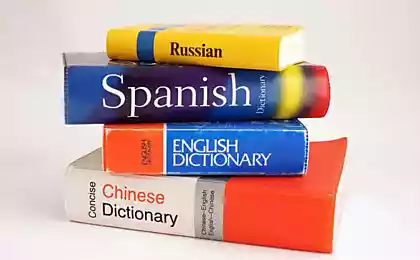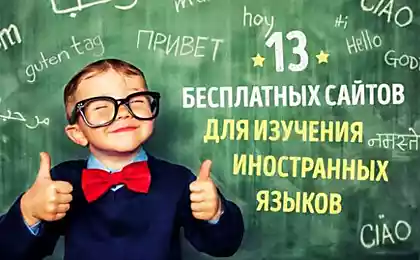1190
The most unusual languages
Let's talk about ... languages other than English, Russian or German, but of those languages, which in the mouth of humans and animals Language - a body that has virtually all vertebrates and it they can do different things. I offer you 10 of the most unusual languages.

Language of the blue whale. Weighs this body up to three tonnes, but come across instances twice as heavy. This is definitely the biggest language in the animal world. And while its relative size is very small compared to the size and weight of a whale, which is 70 tons. The language is a big animal uses as a bucket, scooping water and filtering out of her own food (plankton). By the way, in the language of a blue whale can accommodate fifty people!
The best-known language in the world of animals - language chameleon (I mentioned about this unusual animal in the article Quick animals. Chameleon has the longest tongue - he had some individuals can reach a body length with a tail. It is also a very fast language " shot "spent 40 milliseconds, to" recharge "- half a second. The language of the chameleon is a long tube with a sticky ball at the end, consisting of a special secret, which is released by special glands. When folded, the language has evolved around a special bone in the mouth of a chameleon, which is called Processus entoglossus. For shot chameleon should relax the longitudinal muscles that hold the tongue and acting like a spring. Some chameleons can be up to 70 cm in length, and can catch the language of not only insects, but even small birds and small rodents.
The longest tongue relative to the length of the body, has a small salamander, measuring just 6 cm long. Language her while up to 7 centimeters! Generally, salamanders - amazing creatures. In addition they have a long tongue a few more interesting features. For example, some varieties are not afraid of direct exposure to naked flame for a few seconds. while their skin starts to allocate a large number of special substances that protect the animal from heat, allowing a run. So the legend of noncombustible lizards baseless
Language giant pangolin with a body length of 1 meter up to 80 cm in length. But this is not its main feature. Its uniqueness is that the muscles, resulting in movement of language, developed remarkably and extend along the entire body, being attached to the bone almost near the tail. This feature gives the animal the ability to cope with a large number of termites, which he loves (eating)
The language of giraffe over half a meter in length, being the strongest and longest among ungulates. Language and palate giraffe is so developed and rough that it can easily be controlled with the thorny plants like acacia. Have you ever tried to lick or chew acacia? That's the same A giraffe is a piece of cake.
In many languages of the world is an expression of "loose tongue". We know that language is really no bones. But there are animals whose bones in the language, oddly enough, there is. For example, this fish family Osteoglossiformes. Markups their name in Latin and it means - "bony tongue". The most significant representatives of this family - the giant Arapaima, are found in the Amazon. The length of these sprats of up to 4 and a half meters, and weight - 200 kilograms.
Kruglogubaya bat is found in the mountains of Ecuador. Its size is the same. like ordinary field mouse, but the language has a length of 9 centimeters. These mice somehow believe vampires, although they feed on flower nectar, like a hummingbird. The relative size of the language of the mouse is second only indicators of a chameleon, and holds primacy among all mammals. On the tongue of the bat, there are a lot of hairs, which absorb nectar and carry pollen from tree to tree.
Shellfish is also a similarity of language, it is called a radula (rasp). In the language in the common garden snail is about 15 thousand teeth. The terrible beast!
Language chelydridae looks like a big red worm with which it lures its prey. For this turtle lays on the bottom, he opens his mouth and begins to waggle his tongue-bait. Fish, attracted by it, the turtle swims into the mouth, and she had no choice but to close it and eat the poor fellow.
And finally, a bit of piquancy. There is a bird - a flamingo. So it has a special language. Hunt Flamingos in shallow water, dropping his head into the water, waving his tongue and shaking his head, acting as the language of the pump, driving in the beak of algae and small crustaceans. But the most interesting thing in this whole process is that the language in the process behaves like a penis. He becomes greater due to special tissues that make up. After a few seconds of the "catching" the tongue becomes harder and more effectively drives the water into the center of the beak, where it is filtered and displayed on its sides. Here is a mysterious bird - a flamingo. No one else in the animal world there is such a feature - variable firmness language in large limits.

Language of the blue whale. Weighs this body up to three tonnes, but come across instances twice as heavy. This is definitely the biggest language in the animal world. And while its relative size is very small compared to the size and weight of a whale, which is 70 tons. The language is a big animal uses as a bucket, scooping water and filtering out of her own food (plankton). By the way, in the language of a blue whale can accommodate fifty people!
The best-known language in the world of animals - language chameleon (I mentioned about this unusual animal in the article Quick animals. Chameleon has the longest tongue - he had some individuals can reach a body length with a tail. It is also a very fast language " shot "spent 40 milliseconds, to" recharge "- half a second. The language of the chameleon is a long tube with a sticky ball at the end, consisting of a special secret, which is released by special glands. When folded, the language has evolved around a special bone in the mouth of a chameleon, which is called Processus entoglossus. For shot chameleon should relax the longitudinal muscles that hold the tongue and acting like a spring. Some chameleons can be up to 70 cm in length, and can catch the language of not only insects, but even small birds and small rodents.
The longest tongue relative to the length of the body, has a small salamander, measuring just 6 cm long. Language her while up to 7 centimeters! Generally, salamanders - amazing creatures. In addition they have a long tongue a few more interesting features. For example, some varieties are not afraid of direct exposure to naked flame for a few seconds. while their skin starts to allocate a large number of special substances that protect the animal from heat, allowing a run. So the legend of noncombustible lizards baseless
Language giant pangolin with a body length of 1 meter up to 80 cm in length. But this is not its main feature. Its uniqueness is that the muscles, resulting in movement of language, developed remarkably and extend along the entire body, being attached to the bone almost near the tail. This feature gives the animal the ability to cope with a large number of termites, which he loves (eating)
The language of giraffe over half a meter in length, being the strongest and longest among ungulates. Language and palate giraffe is so developed and rough that it can easily be controlled with the thorny plants like acacia. Have you ever tried to lick or chew acacia? That's the same A giraffe is a piece of cake.
In many languages of the world is an expression of "loose tongue". We know that language is really no bones. But there are animals whose bones in the language, oddly enough, there is. For example, this fish family Osteoglossiformes. Markups their name in Latin and it means - "bony tongue". The most significant representatives of this family - the giant Arapaima, are found in the Amazon. The length of these sprats of up to 4 and a half meters, and weight - 200 kilograms.
Kruglogubaya bat is found in the mountains of Ecuador. Its size is the same. like ordinary field mouse, but the language has a length of 9 centimeters. These mice somehow believe vampires, although they feed on flower nectar, like a hummingbird. The relative size of the language of the mouse is second only indicators of a chameleon, and holds primacy among all mammals. On the tongue of the bat, there are a lot of hairs, which absorb nectar and carry pollen from tree to tree.
Shellfish is also a similarity of language, it is called a radula (rasp). In the language in the common garden snail is about 15 thousand teeth. The terrible beast!
Language chelydridae looks like a big red worm with which it lures its prey. For this turtle lays on the bottom, he opens his mouth and begins to waggle his tongue-bait. Fish, attracted by it, the turtle swims into the mouth, and she had no choice but to close it and eat the poor fellow.
And finally, a bit of piquancy. There is a bird - a flamingo. So it has a special language. Hunt Flamingos in shallow water, dropping his head into the water, waving his tongue and shaking his head, acting as the language of the pump, driving in the beak of algae and small crustaceans. But the most interesting thing in this whole process is that the language in the process behaves like a penis. He becomes greater due to special tissues that make up. After a few seconds of the "catching" the tongue becomes harder and more effectively drives the water into the center of the beak, where it is filtered and displayed on its sides. Here is a mysterious bird - a flamingo. No one else in the animal world there is such a feature - variable firmness language in large limits.
























